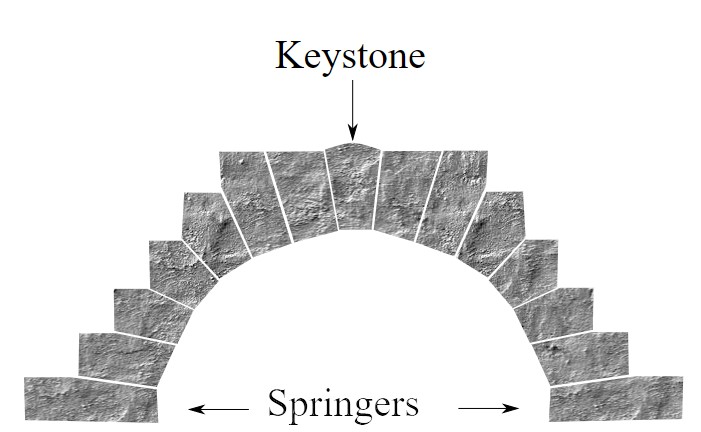Voussoir

|
| This image depicts the voussoir stones of an arch, including the keystone and the springers. |
Contents |
[edit] Introduction
The construction of traditional masonry arches and vaults is dependent on the arrangement of the bricks, blocks or stones over the opening. A tapered or wedge-shaped stone forming one of the units of the arch or vault is called a voussoir. Downward pressure on the structure has the effect of forcing the voussoirs together (in compression) instead of apart. Precision must be used when cutting voussoirs in order to ensure that this pressure is sufficient and uniform against the adjacent blocks.
Each unit in an arch or vault is a voussoir. The voussoir that is positioned in the centre of the arch is known as the keystone. The bottom voussoirs resting on the springing line are referred to as springers. The springing line is the point from which the arch starts to rise from its vertical supports.
[edit] Origins of the term
The term voussoir comes from the old French word vosoir, which has its origins in the Vulgar Latin word volvere (meaning to turn around or to roll). It is this reference, “to turn or roll”, that relates to the action of the wedge-shaped voussoir. Each voussoir rolls to the side to force it into place and create the supporting action needed to distribute weight.
[edit] History
Early voussoirs appeared in 16th century arches found in Italian Mannerist architecture. The technique created a stylistic departure from traditional Renaissance structures. They were also used with dramatic effect in other parts of the Mediterranean, sometimes created using red and white stones arranged in alternating patterns. This effect was also used in Romanesque architecture.
By the 18th and 19th century, bricks and mortar were used to create a new type of voussoir. British bricklayers found they could use standard bricks by thickening vertical mortar joints to produce an arch that was sufficiently supportive.
[edit] Related articles on Designing Buildings
Featured articles and news
Infrastructure that connect the physical and digital domains.
Harnessing robotics and AI in challenging environments
The key to nuclear decommissioning and fusion engineering.
BSRIA announces Lisa Ashworth as new CEO
Tasked with furthering BSRIA’s impressive growth ambitions.
Public buildings get half a million energy efficiency boost
£557 million to switch to cleaner heating and save on energy.
CIOB launches pre-election manifesto
Outlining potential future policies for the next government.
Grenfell Tower Inquiry announcement
Phase 2 hearings come to a close and the final report due in September.
Progress from Parts L, F and O: A whitepaper, one year on.
A replicated study to understand the opinion of practitioners.
ECA announces new president 2024
Electrical engineer and business leader Stuart Smith.
A distinct type of countryside that should be celebrated.
Should Part O be extended to existing buildings?
EAC brands heatwave adaptation a missed opportunity.
Definition of Statutory in workplace and facilities management
Established by IWFM, BESA, CIBSE and BSRIA.
Tackling the transition from traditional heating systems
59% lack the necessary information and confidence to switch.
The general election and the construction industry
As PM, Rishi Sunak announces July 4 date for an election.
Eco apprenticeships continue help grow green workforce
A year after being recognised at the King's coronation.
Permitted development rights for agricultural buildings
The changes coming into effect as of May 21, 2024.





















